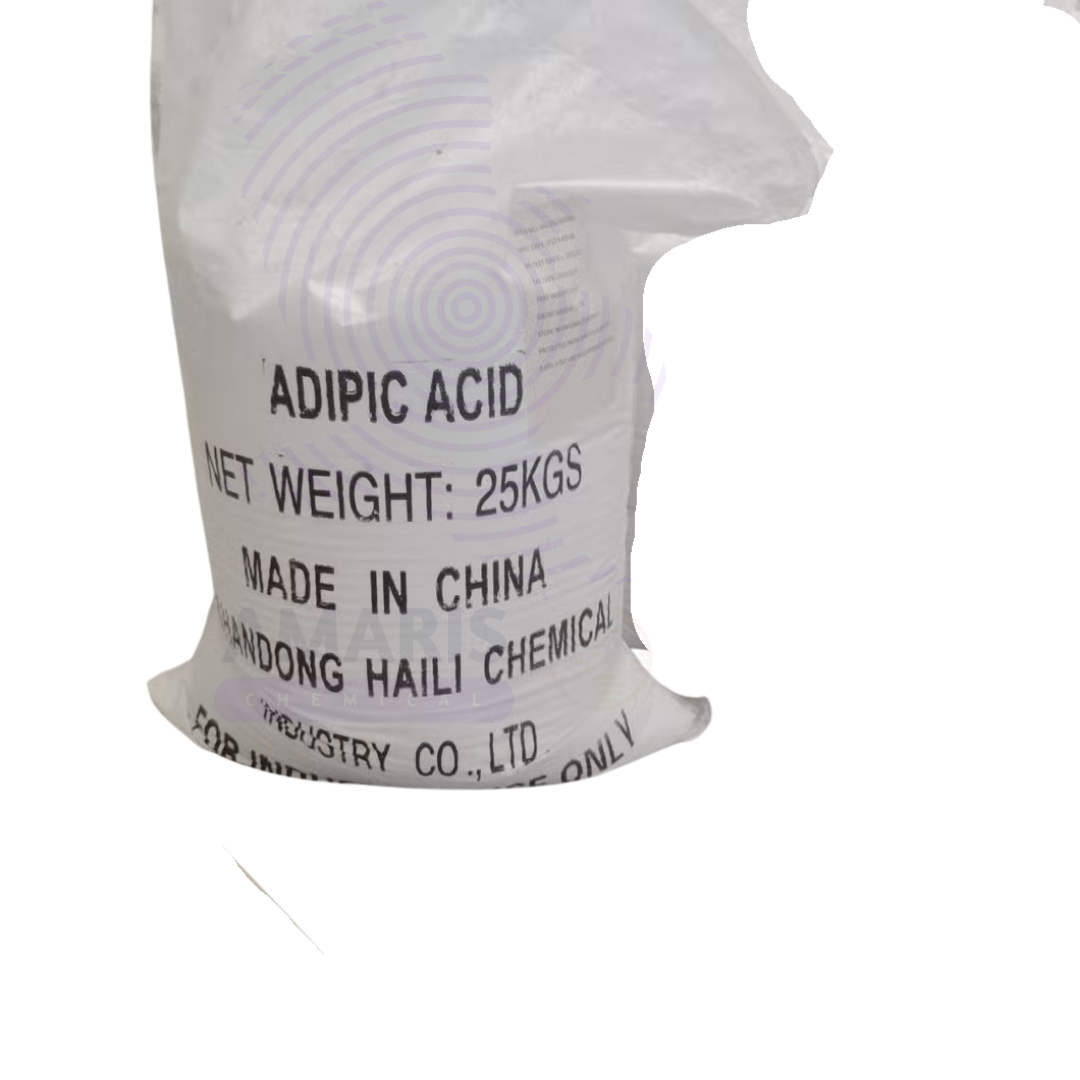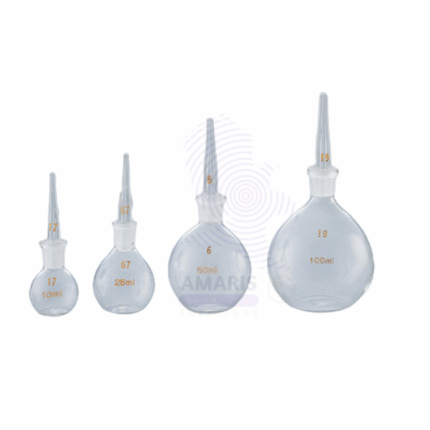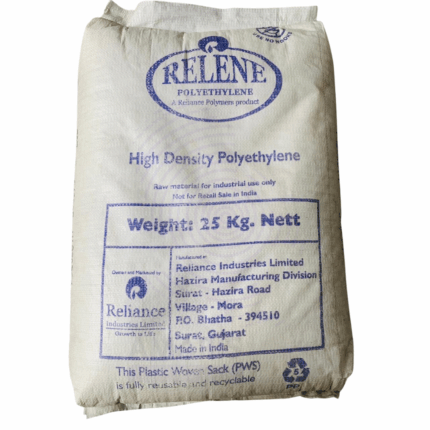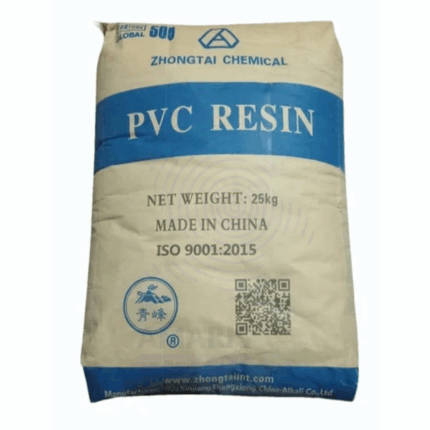Back to products
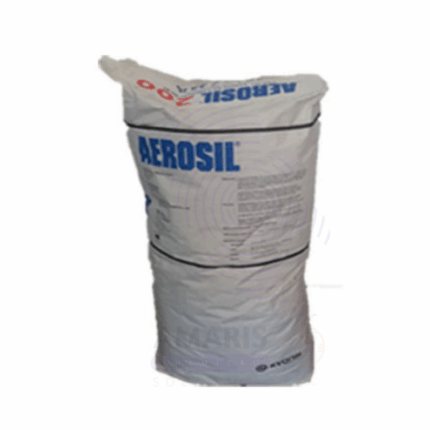

Aerosil 200
$ 7.00 Original price was: $ 7.00.$ 6.90Current price is: $ 6.90.
Adipic Acid
$ 4.00 Original price was: $ 4.00.$ 3.80Current price is: $ 3.80.
Whatsapp Order
Adipic acid is a white, crystalline dicarboxylic acid with the chemical formula C₆H₁₀O₄. It is primarily used as a key raw material in the production of nylon 6,6 and also finds applications in plasticizers, polyurethanes, lubricants, and food additives (as an acidity regulator, E355).
Description
Table of Contents
Toggle
Adipic Acid
Primary Uses
- Nylon 6,6 Production
- The #1 industrial use (~90% of global adipic acid).
- Reacts with hexamethylenediamine (HMDA) to form Nylon 6,6, used in:
- Textiles (clothing, carpets)
- Engineering plastics (car parts, electronics)
- Industrial fibers (ropes, tire cords)
- Polyurethane Foams
- Key components in flexible foams (mattresses, car seats) and coatings/adhesives.
- Food & Beverage Additive (E355)
- Acidulant in gelatin, powdered drinks, and baking powders (imparts tartness).
- pH adjuster in processed foods (regulated for safe consumption).
- Plasticizers
- Used in PVC products (cables, flooring) to improve flexibility.
- Lubricants & Greases
- Enhances thermal stability in synthetic lubricants.
Secondary Uses
- Pharmaceuticals
- Precursor for controlled-release drug formulations.
- Used in antiseptic and antifungal creams.
- Cosmetics
- pH adjuster in lotions and creams.
- Agriculture
- Slow-release fertilizer coatings.
- Electronics
- Etching agent in semiconductor manufacturing.
- Military & Explosives
- Historical use in ammonium adipate propellants (less common today).
PRODUCT KEY ATTRIBUTES
. Basic Identification Attributes
- Chemical Name (IUPAC): Hexanedioic acid
- Common/Trade Names:
- Adipic acid
- 1,4-Butanedicarboxylic acid
- AA (abbreviation)
- CAS Number: [124-04-9]
- HS Code: 2917.12.00 (Acyclic polycarboxylic acids)
- Molecular Formula: C₆H₁₀O₄
- Synonyms:
- Acifloctin
- Adilactetten
- Hexane-1,6-dioic acid
2. Physical & Chemical Properties
- Physical State: White crystalline powder
- Color & Odor: White; odorless
- Melting Point: 152–154°C (305–309°F)
- Boiling Point: 337°C (639°F) (decomposes)
- Density: 1.36 g/cm³ (at 25°C)
- Solubility:
- Water: 14 g/L (20°C), highly soluble in hot water
- Organic solvents: Soluble in ethanol, acetone; slightly soluble in ether
- pH Level: ~3.5 (0.1% solution, acidic)
- Vapor Pressure: <0.1 mmHg (20°C)
- Flash Point: 196°C (385°F) (closed cup)
- Autoignition Temperature: 420°C (788°F)
- Viscosity: N/A (solid)
- Refractive Index: 1.428 (20°C)
3. Safety & Hazard Attributes
- Hazard Class (GHS):
- Skin Irritation (Category 2)
- Eye Irritation (Category 2A)
- Not flammable or explosive
- NFPA Ratings:
- Health: 1
- Flammability: 1
- Reactivity: 0
- Exposure Limits:
- OSHA PEL: 5 mg/m³ (total dust)
- ACGIH TLV: 5 mg/m³ (inhalable particles)
- Reactivity:
- Stable under normal conditions
- Reacts with strong oxidizers (e.g., peroxides, chlorates)
- Forms salts with bases
4. Storage & Handling Attributes
- Storage Conditions:
- Cool, dry, well-ventilated area
- Keep away from oxidizers and moisture
- Incompatible Materials:
- Strong bases (e.g., NaOH)
- Strong oxidizers (e.g., nitric acid)
- Container Type:
- Polyethylene-lined bags or fiber drums
- Stainless steel for bulk storage
- Shelf Life: Indefinite if stored properly
- Special Handling:
- Use dust masks (NIOSH N95) to avoid inhalation
- Wear gloves and goggles to prevent irritation
5. Regulatory & Compliance Attributes
- Regulatory Status:
- FDA (USA): Approved for food use (21 CFR 184.1009)
- EU: Food additive E355
- REACH: Registered
- Hazard Symbols (GHS):
- Exclamation mark (irritant)
- Transportation Restrictions:
- Not classified as hazardous (non-regulated)
- UN number: None required
- Waste Disposal:
- Incinerate or dispose in licensed landfills
- Neutralize with base if required
6. Environmental & Health Impact
- Ecotoxicity:
- LC50 (fish): >100 mg/L (low toxicity)
- EC50 (daphnia): >100 mg/L
- Persistence in Environment:
- Readily biodegradable (>60% in 28 days, OECD 301B)
- Carcinogenicity/Mutagenicity:
- IARC: Not classified
- NTP: Not listed
- OSHA: No carcinogenic effects
- Biodegradability:
- Degrades in water/soil (half-life: days to weeks)
SAFETY HANDLING
- Safety precautions
Personal Protective Equipment (PPE):
- Gloves: Nitrile or neoprene
- Eye Protection: Chemical splash goggles
- Respiratory: N95 dust mask (for powder handling)
- Clothing: Lab coat or protective apron
Handling & Storage:
- Store in cool, dry, well-ventilated area
- Keep containers tightly closed
- Avoid contact with strong oxidizers (risk of violent reaction)
- Ground equipment to prevent static discharge
Hygiene Practices:
- No eating/drinking in handling areas
- Wash hands thoroughly after use
- Provide emergency eyewash station
2. First Aid Measures
Skin Contact:
- Remove contaminated clothing
- Wash with soap and water for 15 minutes
- Seek medical attention if irritation persists
Eye Contact:
- Flush with lukewarm water for 15-20 minutes
- Hold eyelids open during rinsing
- Seek immediate medical attention
Inhalation:
- Move to fresh air
- Administer oxygen if breathing is difficult
- Get medical help if symptoms persist
Ingestion:
- Rinse mouth with water
- Drink milk or water to dilute
- Do NOT induce vomiting
- Seek medical attention
3. Firefighting Measures
Fire Characteristics:
- Combustible solid (powder form)
- Decomposes at >230°C releasing irritating fumes
- Forms explosive dust-air mixtures
Extinguishing Media:
- Water spray
- Dry chemical powder
- CO₂
- Alcohol-resistant foam
Special Precautions:
- Wear self-contained breathing apparatus (SCBA)
- Cool containers with water spray
- Prevent dust cloud formation
4. Spill Management
Small Spills:
- Wear appropriate PPE
- Sweep up carefully (avoid raising dust)
- Place in sealed container
Large Spills:
- Dampen with water to control dust
- Use non-sparking tools for cleanup
- Prevent entry into drains/waterways
Disposal:
- Dispose as non-hazardous waste (unless contaminated)
- Follow local regulations
Related products
Epikote 828 (Epoxy Resin)
Epikote 828 is a liquid bisphenol-A-based epoxy resin with a low molecular weight. It is one of the most widely used general-purpose epoxy resins in industrial applications due to its excellent mechanical, chemical, and thermal properties. Epikote 828 cures with various hardeners, especially amines, to form thermoset polymers with outstanding adhesion, chemical resistance, and dimensional stability. The resin is typically a clear to pale yellow viscous liquid and is soluble in most organic solvents. It is primarily used in coatings, adhesives, composites, electrical encapsulation, flooring systems, and structural materials.
HDPE Blow HDB5502
HDPE Blow HDB5502 is a high-density polyethylene resin specifically formulated for blow molding applications. It is a semi-crystalline thermoplastic polymer characterized by excellent strength-to-density ratio, high chemical resistance, and superior processability in blow molding equipment. This grade exhibits high stiffness, good environmental stress crack resistance (ESCR), and excellent impact resistance, making it ideal for manufacturing durable hollow containers and complex-shaped products. The resin is supplied as granular pellets with consistent melt flow and homogeneity, optimized for efficient molding cycles and high throughput.
Isopropyl Myristate
Isopropyl Myristate is a clear, colorless, and oily liquid ester formed by the reaction of isopropyl alcohol and myristic acid. It has a mild, pleasant odor and excellent spreading properties. IPM is widely used in cosmetics, pharmaceuticals, and industrial applications as an emollient, solvent, and penetration enhancer due to its ability to improve texture and absorption of topical formulations.
Parallizer (UFABLEND)
Product Description
Parallizer (UFABLEND) is a versatile liquid paralytic agent used primarily in the formulation of pesticides and herbicides to enhance the immobilization of target pests. It acts by disrupting the nervous system of insects and other pests, providing quick knockdown effects. UFABLEND is valued for its fast action, compatibility with other agrochemicals, and stability under various environmental conditions.PVC Resin 701
PVC Resin 701 is a high-quality suspension-grade polyvinyl chloride resin with a K-value of approximately 70–71, indicating high molecular weight. It is widely used in the production of flexible PVC products where excellent strength, elongation, and plasticizer absorption are required. PVC Resin 701 offers superior mechanical properties, high thermal stability, and good compatibility with plasticizers, making it suitable for calendaring, extrusion, and molding applications in diverse industries.
Sasol Phenol
Sasol Phenol is a high-purity, industrial-grade phenol produced by Sasol, widely used as a key raw material in the manufacture of plastics, resins, and chemicals. Phenol is an aromatic organic compound characterized by a hydroxyl group (-OH) attached to a benzene ring. It serves as a precursor in producing bisphenol A, caprolactam, and phenolic resins. Sasol Phenol is known for its consistent quality, purity, and suitability for diverse industrial applications including chemical synthesis, pharmaceuticals, and adhesives.
Setamine (Melamine Resin)
Setamine (Melamine Resin) is a thermosetting polymer widely used for its excellent hardness, chemical resistance, and thermal stability. It is produced by the reaction of melamine with formaldehyde and is commonly utilized in coatings, laminates, adhesives, and molding compounds. Setamine offers superior durability, scratch resistance, and moisture resistance, making it ideal for high-performance surface finishes and industrial applications.
Styrene Polymer Copolymer (230kg)
Styrene Polymer Copolymer is a high-performance copolymer consisting primarily of styrene combined with other monomers such as acrylonitrile or butadiene, designed to offer enhanced mechanical properties, chemical resistance, and processability. Supplied in bulk packaging of 230kg, it is widely used in plastics, adhesives, coatings, and rubber industries. This copolymer provides excellent toughness, thermal stability, and versatility, making it suitable for demanding industrial applications.


 Preservatives(food)
Preservatives(food) Flavor Enhancers
Flavor Enhancers Acidulants
Acidulants Sweeteners
Sweeteners Antioxidants
Antioxidants Colorants(food)
Colorants(food) Nutraceutical Ingredients (food)
Nutraceutical Ingredients (food) Nutrient Supplements
Nutrient Supplements Emulsifiers
Emulsifiers
 Collectors
Collectors Dust Suppressants
Dust Suppressants Explosives and Blasting Agents
Explosives and Blasting Agents Flocculants and Coagulants
Flocculants and Coagulants Frothers
Frothers Leaching Agents
Leaching Agents pH Modifiers
pH Modifiers Precious Metal Extraction Agents
Precious Metal Extraction Agents
 Antioxidants(plastic)
Antioxidants(plastic) Colorants (Pigments, Dyes)
Colorants (Pigments, Dyes) Fillers and Reinforcements
Fillers and Reinforcements Flame Retardants
Flame Retardants Monomers
Monomers Plasticizers
Plasticizers Polymerization Initiators
Polymerization Initiators Stabilizers (UV, Heat)
Stabilizers (UV, Heat)
 Antifoaming Agents
Antifoaming Agents Chelating Agents
Chelating Agents Coagulants and Flocculants
Coagulants and Flocculants Corrosion Inhibitors
Corrosion Inhibitors Disinfectants and Biocides
Disinfectants and Biocides Oxidizing Agents
Oxidizing Agents pH Adjusters
pH Adjusters Scale Inhibitors( water)
Scale Inhibitors( water)
 Antioxidants(cosmetic)
Antioxidants(cosmetic) Emollients
Emollients Fragrances and Essential Oils
Fragrances and Essential Oils Humectants
Humectants Preservatives
Preservatives Surfactants(cosmetic)
Surfactants(cosmetic) Thickeners
Thickeners UV Filters
UV Filters
 Fertilizers
Fertilizers Soil Conditioners
Soil Conditioners Plant Growth Regulators
Plant Growth Regulators Animal Feed Additives
Animal Feed Additives Biostimulants
Biostimulants Pesticides (Herbicides, Insecticides, Fungicides)
Pesticides (Herbicides, Insecticides, Fungicides)
 Active Pharmaceutical Ingredients (APIs)
Active Pharmaceutical Ingredients (APIs) Excipients
Excipients Solvents(pharmaceutical)
Solvents(pharmaceutical) Antibiotics
Antibiotics Antiseptics and Disinfectants
Antiseptics and Disinfectants Vaccine Adjuvants
Vaccine Adjuvants Nutraceutical Ingredients (pharmaceutical)
Nutraceutical Ingredients (pharmaceutical) Analgesics & Antipyretics
Analgesics & Antipyretics
 Analytical Reagents
Analytical Reagents Solvents(lab)
Solvents(lab) Chromatography Chemicals
Chromatography Chemicals Spectroscopy Reagents
Spectroscopy Reagents microbiology-and-cell-culture-reagents
microbiology-and-cell-culture-reagents Molecular Biology Reagents
Molecular Biology Reagents Biochemical Reagents
Biochemical Reagents Inorganic and Organic Standards
Inorganic and Organic Standards Laboratory Safety Chemicals
Laboratory Safety Chemicals Specialty Laboratory Chemicals(Special Laboratory Equipment)
Specialty Laboratory Chemicals(Special Laboratory Equipment)
 Demulsifiers
Demulsifiers Hydraulic Fracturing Fluids
Hydraulic Fracturing Fluids Scale Inhibitors(oil)
Scale Inhibitors(oil) Surfactants(oil)
Surfactants(oil) Drilling Fluids
Drilling Fluids
 Dyes and Pigments
Dyes and Pigments Bleaching Agents
Bleaching Agents Softening Agents
Softening Agents Finishing Agents
Finishing Agents Antistatic Agents
Antistatic Agents
 Admixtures
Admixtures Waterproofing Agents
Waterproofing Agents Sealants and Adhesives
Sealants and Adhesives Curing Compounds
Curing Compounds Concrete Repair Chemicals
Concrete Repair Chemicals Anti-Corrosion Coatings
Anti-Corrosion Coatings
 Surfactants(cleaning)
Surfactants(cleaning) Builders
Builders Enzymes
Enzymes Solvents (Cleaning)
Solvents (Cleaning) Fragrances
Fragrances
 Electronic Chemicals
Electronic Chemicals Catalysts
Catalysts Lubricants
Lubricants Photographic Chemicals
Photographic Chemicals Refrigerants
Refrigerants Automotive chemicals
Automotive chemicals Pyrotechnic Chemicals
Pyrotechnic Chemicals
 Biodegradable Surfactants
Biodegradable Surfactants Bio-based Solvents
Bio-based Solvents Renewable Polymers
Renewable Polymers Carbon Capture Chemicals
Carbon Capture Chemicals Wastewater Treatment Chemicals
Wastewater Treatment Chemicals
 Pigments
Pigments Solvents(paint)
Solvents(paint) Specialty Coatings
Specialty Coatings Binders/Resins
Binders/Resins Additives
Additives Driers
Driers Anti-Corrosion Agents
Anti-Corrosion Agents Functional Coatings
Functional Coatings Application-Specific Coatings
Application-Specific Coatings
 Fresh Herbs
Fresh Herbs Ground Spices
Ground Spices Whole Spices
Whole Spices Spice Blends
Spice Blends Dried Herbs
Dried Herbs
 Leavening Agents
Leavening Agents Dough Conditioners
Dough Conditioners Flour Treatments
Flour Treatments Fat Replacers
Fat Replacers Decoratives
Decoratives Preservatives(baking)
Preservatives(baking)
 Plasticizers & Softeners
Plasticizers & Softeners Reinforcing Agents
Reinforcing Agents Adhesion Promoters
Adhesion Promoters Vulcanizing Agents
Vulcanizing Agents Antidegradants
Antidegradants Blowing Agents
Blowing Agents Fillers & Extenders
Fillers & Extenders Accelerators & Retarders
Accelerators & Retarders